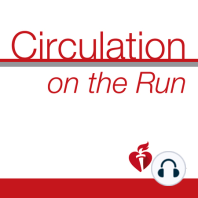18 min listen
Circulation April 20, 2021 Issue
ratings:
Length:
25 minutes
Released:
Apr 19, 2021
Format:
Podcast episode
Description
For this week's Feature Discussion, please join author Marco Vinceti and Associate Editor Wanpen Vongpatanasin as they discuss the article "Blood Pressure Effects of Sodium Reduction: Dose-Response Meta-Analysis of Experimental Studies." TRANSCRIPT BELOW: Dr. Carolyn Lam: Welcome to Circulation on the Run, your weekly podcast summary and backstage pass to the journal and its editors. We're your co-hosts. I'm Dr. Carolyn Lam, Associate Editor from the National Heart Center and Duke National University of Singapore. Dr. Greg Hundley: I'm Dr. Greg Hundley, co-host and Associates Editor, Director of the Pauley Heart Center, Richmond, Virginia, VCU Health Dr. Carolyn Lam: Dr. Greg, today's feature paper, super, super exciting. Everyone has to listen to it because it's about blood pressure and sodium intake. But you think you've heard it all? You haven't. You have to listen to this feature discussion, and I'm sure you'll learn a lot, just like I did. Seriously. But before that you got your copy, I got mine. Let me tell you all about microRNA. Shall I? Dr. Greg Hundley: Absolutely. Dr. Carolyn Lam: MicroRNA, we know, have a remarkable influence on the physiology of the heart and the remodeling of diseased hearts through canonical RNA interference mechanisms. Now, the authors of today's paper, co-corresponding authors, Dr. Fu and Deschênes from Ohio State University in Columbus, Ohio, investigated if microRNA one or mir-1 specifically binds with cardiac plasma membrane proteins, and they revealed an evolutionarily-conserved direct binding between this mir-1 and an inward rectifier potassium channel called cure 2.1. Now, this is endogenously existing in cardiomyocytes. Dr. Carolyn Lam: Now, the authors then used inside out and wholesale patch clamp recordings to show the biophysical modulation of cardiac electrophysiology by mir-1. They further studied the mechanism of this physical interaction and investigated its pathophysiologic relevance by using mir-1 deficient transgenic mice. In total, their study demonstrated a novel mechanism of microRNA ion channel biophysical modulation that regulates cardiac arrhythmia risk. Dr. Greg Hundley: Wow, Carolyn really sophisticated work involving the pathophysiology of some of these arrhythmias. What are the take home message? Dr. Carolyn Lam: Ah, I'm glad you asked. Let me circle back to what I said earlier. Cardiac electrophysiology is regulated by microRNAs. We knew about the canonical RNA interference mechanisms, but that needs hours to days to regulate gene expression. But now we have the newly discovered biophysical mechanism that quickly, and that is within seconds or minutes, modulates the function of the ion channels. These microRNAs could prevent or trigger arrhythmias through biophysical modulation of the ion channels, even before its RNA interference regulation of protein expression occurs in diseased hearts. Dr. Greg Hundley: Wow, Carolyn. Really interesting new basic science. Such an asset for our journal. Well, I'm going to switch and talk a little bit about really, really high coronary artery calcium scores, something that sometimes we see. The work comes from Dr. Michael Blaha from Johns Hopkins University in Baltimore, Maryland. Carolyn, as you know, there are limited data on the unique cardiovascular disease and non-cardiovascular disease and mortality risk of primary prevention individuals with very high coronary artery calcium scores. What do we mean by very high? These are scores greater than or equal to a thousand. That's especially true in comparison to rates observed in secondary prevention populations. In this study, the investigators compared the hazard ratios for coronary artery calcium scores greater than a thousand in comparison with calcium scores of zero, those from 400 to 999, and they looked at this for those with cardiovascular disease, non-cardiovascular disease, and also evaluated mortality outcomes. Dr. Carolyn Lam: Oh, wow. That's interesting and those are v
Released:
Apr 19, 2021
Format:
Podcast episode
Titles in the series (100)
Circulation January 23, 2018 Issue by Circulation on the Run
